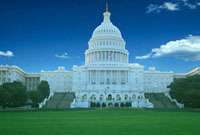It’s been nine weeks since voters turned the national government over to Republican lawmakers, many of whom explicitly vowed to help President Bush and his industrial allies complete what former GOP House Speaker Newt Gingrich (Ga.) failed to do in 1995: dismantle the nation’s basic protections for water, air, wild lands, forests, and public health.

An uphill battleground.
Since the first hours after the election, senior staff members from the most prominent U.S. green groups have been preparing an action plan to foil the Republican assault on the environment — and today, when Congress reconvenes, that plan will be launched. It includes a multi-front defense to thwart the administration’s efforts to weaken environmental safeguards, and a counterattack designed to build a much larger constituency and transform the environment into a high-priority political issue.
Never in U.S. history have national environmental organizations faced such a formidable political challenge. But in interviews, some of the country’s most prominent environmentalists say the crisis may present a singular opportunity to reinvigorate the environmental movement.
“We are pulling together our collective resources, reaching out to the grassroots, and developing messages,” says Brent Blackwelder, president of Washington, D.C.-based Friends of the Earth, who has been active in preparing the defense strategy. “Collaboration between all the [environmental] groups has dramatically improved. It’s not an opportunity that any of us looked forward to, but we also understand what we’re dealing with. There is real strength in our numbers.”
United We Plan

Michigan Gov. Jennifer
Granholm (D).
The “Collaborative Defense Campaign,” as it is being called, is perhaps the broadest and most ambitious operation ever attempted by the national environmental community. Staff members from 16 environmental organizations (about half of the more than 30 national green organizations with offices in D.C.) are helping to develop and implement it. Those involved say the campaign, which grows out of an effort begun in 2001 in anticipation of the administration’s sweeping assault on the environment, is being coordinated by Gene Karpinski, executive director of the U.S. Public Interest Research Group, and Greg Wetstone, the director of advocacy at the Natural Resources Defense Council.
According to Friends of the Earth’s Blackwelder and almost a dozen other environmental leaders interviewed for this article, the strategic plan entails:
- Forging much stronger alliances with state leaders (such as New York Attorney General Eliot Spitzer, a Democrat, and the new Democratic governor of Michigan, Jennifer Granholm) to ensure strong state-level responses to federal attempts to water down environmental protections.
- Focusing on a select group of highly visible skirmishes that citizens will immediately understand (such as offshore oil and gas drilling, forest cutting, water pollution, and public-health threats caused by weakening the Clean Air Act) and garnering national attention for these issues through targeted court actions, the Internet, email alerts, and state and national media blitzes.
- Helping state and regional organizations battle the administration’s proposals on the ground — for example, supporting efforts by Montana’s Greater Yellowstone Coalition to phase out snowmobiles in Yellowstone National Park, a move the White House opposes.
- Recruiting prominent new messengers (for instance, manufacturing executives, chambers of commerce, religious leaders, and sympathetic moderate Republican lawmakers such as New York Gov. George Pataki and Sens. Olympia Snowe (Maine) and Lincoln Chafee (R.I.) to publicly oppose the retreat on environmental protections.
- Finding and selecting one or two administration proposals with the potential to divide congressional Republicans and using them to turn the president’s campaign against the environment into a major domestic political story that receives daily front-page and television news coverage.
- Convincing Democratic leaders that they can win votes by defending environmental laws and by being more public and pointed in their criticism of the administration’s attempts to open the nation’s natural resources to exploitation.

Sen. Olympia Snowe
(R-Maine).
“We’re expecting a hell of a year,” says Rodger Schlickeisen, president of Defenders of Wildlife, who is among the important strategists behind the campaign and is also helping to oversee its collaborative Save Our Environment website. “There’s nothing like a firing squad to get your attention.”
Brewing the Perfect Storm
Indeed, there’s no mistaking the political might arrayed in Washington to roll back three decades of progress on conserving natural resources and reducing pollution. The New York Times called the Republican takeover in Washington the “perfect storm” for wrecking environmental programs, and it’s easy to see why: The White House and right-wing Republicans have the support of the energy, mining, and timber industries, home builders and realtors, road builders, large manufacturers, “free market” think tanks, and conservative media outlets, particularly Fox TV. Together, this formidable alliance is poised to take advantage of what it sees as a once-in-a-generation political opportunity.
“Our landmark environmental measures have been challenged before, most notably in the James Watt era and in the Newt Gingrich Congress, but never through a campaign as far-reaching and destructive as the threat posed today by the Bush administration and the new Congress,” says Collaborative Defense Campaign co-chair Wetstone.
But Wetstone and others involved in the planning to counter the administration attack on the environment say national environmental organizations are far from defenseless. In fact, they argue, the environmental community is better financed, more technically qualified, more closely tied to regional and state advocacy organizations, more prepared to file successful lawsuits, and more capable of influencing public views through the Internet, email, and their own publications and the media than ever before.
This claim is backed by the numbers: Many national environmental organizations are now substantial institutions. The Natural Resources Defense Council boasts a $45 million annual budget and about 280 staff members on two coasts, according to Wetstone. Environmental Defense had $44 million in revenues last year and has almost 250 staff members in New York, Washington, and other regional offices. The Wilderness Society and Defenders of Wildlife each have $20 million per year to spend on advancing environmental causes.
Moreover, environmental organizations are collaborating more closely than ever before. Although Karpinski, Wetstone, and Schlickeisen declined to discuss the full breadth of the committee’s plan, participants say they have divided into tactical working groups on Congress, legal actions, regulatory rollbacks, outreach to the states and the grassroots, gaining access to the media, and overall communications. Working groups are focusing on the Clean Air Act, the Clean Water Act, the National Environmental Policy Act, the Endangered Species Act, climate change, energy, public lands, forests, and oceans, according to some of those participating.
National organizations say the strategy is principally focused on making sure harmful administration proposals are quickly identified, immediately framed for the public, and broadly disseminated in ways that will enable states and local communities to hold their lawmakers accountable.
For instance, Norm Coleman, the new Republican senator from Minnesota, could face a surprise at home if he joins the White House in opposing safeguards for clean water. If he does so, environmental organizations are poised to place ads in Minnesota newspapers and on the radio that would position Coleman as an enemy of duck hunters and anglers, two economically important groups that depend on thousands of acres of wetlands protected by the federal Clean Water Act. Sen. James Inhofe (R-Okla.), the new chair of the Senate Committee on Environment and Public Works, could be another prominent lawmaker to feel the heat at home for his participation in Bush’s anti-environment agenda. In 1992, the Clean Water Act provided Oklahoma citizens with the legal tools to win a U.S. Supreme Court pollution-control case. The win forced Arkansas industries located along the Arkansas River to meet Oklahoma’s water-quality standards and stop soiling downstream Oklahoma communities. Water pollution caused by manure flowing from factory farms has also been a big issue in Oklahoma. If Inhofe tries to weaken federal clean water protections, as many in D.C. expect he will, environmental organizations will make sure his constituents know that their senator is trying to weaken the very laws that have helped protect their state.
“One of the things we talk about all the time is to expose the hell out of them and do whatever we can to make sure the public knows [what’s going on at the federal level] and has a say,” says Schlickeisen.
National Environmental Distrust?
Environmentalism in the United States could be permanently transformed by the intensity of the strategic planning and the way national organizations are integrating their work in Washington with regional offices and state environmental organizations, says Mark Van Putten, president of the D.C.-based National Wildlife Federation. He and others note that traditionally, state and national environmental organizations have acted independently and even competitively, meaning the movement has historically been riven by rivalries.
“We understand the threat [to the environment] is immediate, but many of us look beyond this election cycle and see an opportunity to affirm the importance of long-term outreach to the states,” Van Putten says. “We are mapping out opportunities for environmental leaders at the state level to help in this campaign. We see the states as being very important to countering bad federal policy and even making some gains.”
The Internet, email alert networks, and listservs are central to the communications strategy of this environmental coalition. Most of the national organizations maintain strong websites and manage large email lists, and both can be tools in the battle to counter the Bush administration’s anti-environmentalism. The Natural Resources Defense Council, for instance, publishes what is generally regarded as the best compendium of the administration’s proposals to weaken environmental protections and its email alerts reach more than 500,000 people, including reporters, editors, and broadcasters in the mainstream and the independent media. The U.S. Public Interest Research Group publishes accounts of congressional voting records that reach 1.5 million Americans, the group says.
Environmentalists also say they are battle-tested and capable of holding their own with the White House. That conclusion is based on 22 years of skirmishing with conservative leaders (starting with President Reagan) who consistently if clumsily try to avoid a central fact of modern cultural life: The vast majority of Americans — 70 percent and more in most polls — want their air and water to get cleaner, their forests to remain standing, and their communities to be safe and unpolluted.
“Our polling and other polling shows that the public does not have a lot of trust in this administration to take care of the environment,” says John Russonello, a Beltway-based pollster who is participating in some of the strategic planning. “The public is in no mind to roll back environmental enforcement either at the federal or state level. When the issue is clean water, more than six in 10 favor maintaining regulations even when polling questions assert that regulations are restrictive and expensive.”
The president, other Republicans, and industry executives know about these numbers as well — which is why they are taking care to do their work behind the scenes, in the privacy of lawmakers’ offices and regulatory agency meeting rooms. If the assault on the rules protecting the nation’s natural resources remains a quiet, back-page story, many insiders say, the president will win.
But environmental leaders say that will not happen. In 2001, among other industry-friendly proposals, Bush reneged on a campaign promise to reduce the emissions that contribute to global warming, made moves to strike down new limits on arsenic in drinking water, and pushed to open the Arctic National Wildlife Refuge to drilling. National environmental organizations were the first to call attention to each of these initiatives, frame their significance for the media and the public, and organize at the grassroots to attract public attention so intense that Jay Leno and David Letterman joked about the administration’s environmental policy on national television. These early anti-environmental actions cost the president control of the Senate and contributed to his low approval ratings prior to Sept. 11, 2001.
The big question is whether now, post-Sept. 11, the national environmental groups can once again transform the White House’s bid to exploit America’s resources into a prominent domestic dispute. Leaders say they will.
“Bush is popular. His environmental policies are not. We learned that in 2001,” says Kevin Curtis, general vice president for government affairs at National Environmental Trust, an eight-year-old D.C.-based organization with 50 staff members. “Our community is united. Our work is all about reconnecting with people and demonstrating the saliency of the environment as a political issue.”

